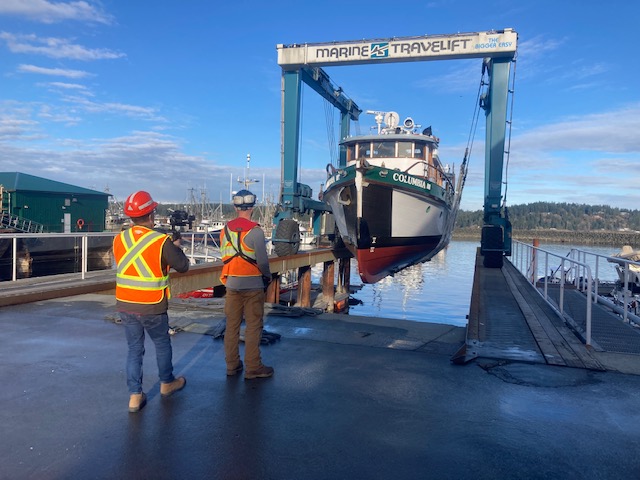Yes, yes, a very quick update as I am swamped.
I have a new-to me-skipper, Jonas Fineman getting ready to do some skippering for me this summer. Jonas owns and operates a wonderful schooner in our local waters. I met Jonas on the Marine Debris Removal Initiate a few years back and I have been dreaming of how to get him incorporated into our team ever since. So to begin the process, Jonas came for a week of pre-shipyard work and then also joined me for another week in the shipyard. This included getting the ship into and out of the shed and lots of practice docking and anchoring the COLUMBIA III. Jonas is a very experienced skipper, but every ship handles differently.
So, true to my evil nature, Jonas’s first task was replacing all the black water lines on the ship.
And it’s a good thing Jonas took on the task with good humour. The combination of urine and salt water makes a calcium-like-cement lining to the 1 1/2″ sani-hose and slowly restricts appropriate “passage” of “target materials”. The next picture is worth 1000 words . . . (This is under 3 seasons of accumulation)
I felt so bad, that whilst Jonas slaved in the black-water plumbing tangles I made him brunch in the ship’s galley . . . 
After the black-water fun I thought I would try baking Jonas, “Hansel and Gretel style”, as he learned how to change the igniter on the galley range . . . essential skipper training . . .
But finally it was time to get the ship out of the shed . . . 
and to the shipyard. I already stress enough each year as the ship gets lifted (it just never seems,”Natural” to have her way up in the air!) but then it started snowing and dumped 6″ in about 3 hours! Does snow make lifting straps more slippery????!!!!
Cool evening light after the snow storm . . .
But the next day, dodging rain squalls, Jonas was keen to get her painted. So he dried the hull with a tiger-torch and we painted the hull ourselves. The Ocean Pacific crews had us slated for the next day but we wanted to grab the weather window when we had it.
The following morning we got the boot-top done . . .
Note Jonas’s amazing technique . . . 
And the shipyard welder replaced our zincs including the poured zinc on the propeller nut.
And the water-line gumwood was cetoled . . .
A Transport Canada inspector came from Nanaimo to check out our hull and said something nice along the lines of, “We shouldn’t waste our time coming to inspect a vessel that is being maintained this well.”
And the COLUMBIA III usually has a few appreciative admirers and this year was no exception. Work Safe BC was in the yard creating a shipyard safety video and asked if they could film the COLUMBIA III as she was relaunched . . . .
and finally back in the shed with her shiny new draft marks!
And now I get to prepare for the S&P crews arriving in a couple of weeks!!!!


























